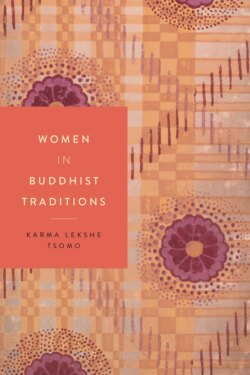Читать книгу Women in Buddhist Traditions - Karma Lekshe Tsomo - Страница 6
На сайте Литреса книга снята с продажи.
NOTE ON TRANSLITERATION AND PRONUNCIATION OF NAMES AND TERMS
ОглавлениеA discussion of women in Buddhist traditions necessarily includes words in the original languages of those traditions. The Theravāda Buddhist traditions are based on scriptures recorded in the Pāli language, whereas the Mahāyāna Buddhist traditions are based on scriptures written in Sanskrit. In this book, the standard transliterations of words in those two South Asian languages include diacritical marks to indicate pronunciation. The reader will note in the text that either Pāli or Sanskrit words are used depending on the tradition and the language of the relevant scriptural sources being discussed. The Mahāyāna Buddhist traditions in China, Tibet, Korea, Japan, and elsewhere are based on the Mahāyāna scriptures, many of which have been translated into their own languages, so Sanskrit terms are used when discussing Mahāyāna Buddhist traditions, in addition to terms in those languages. Some chapters alternately use Pāli and Sanskrit versions of the same word or name, especially when discussing the earliest sources on the life of the Buddha and his teachings, because later written texts were preserved in both these languages.
In transliterations of Pāli or Sanskrit words, a macron (a straight bar) over a vowel indicates an elongated sound. Pāli and Sanskrit words are often similar. For example, the word for a fully ordained nun in Pāli is bhikkhunī and in Sanskrit, bhikṣuṇī. The word for “action” is kamma in Pāli and karma in Sanskrit. Other words, such as “Buddha,” are the same in both Pāli and Sanskrit. The th, dh, ph, and bh sounds are aspirates, not sibulants. Theravāda, for example, is pronounced with a hard t as in “town,” not a dental, as in “thank.” The transliterated letters ś and ṣ are both close to the “sh” sound in English. The Sanskrit ṃ is pronounced as a nasalized n. The Sanskrit consonants ṇ and ḍ are pronounced as nasalized versions of n and d.
The transliteration of Tibetan words follows the Wylie system developed by Turrell V. Wylie in the 1950s, still commonly used today, which avoids diacritical marks. Chinese words are romanized following the Pinyin system. In romanized Japanese words, a macron over a vowel, such as ō, indicates a long vowel.
In the case of names of people, institutions, and places, the transliteration generally follows the phonetic equivalent without diacritics, or the preference of the person or institution. The exception is that diacritical marks are used in the transliterated names of persons mentioned in Buddhist scriptures. For example, Mahāprajāpatī Gautamī is the name in Sanskrit of the Buddha’s aunt and foster mother, while her name in Pāli is Mahāpajāpatī Gautamī.
Although the use of diverse languages may be a bit confusing or inconvenient, it is also a useful reminder that these Buddhist traditions have long histories and spread over a vast geographical expanse. Through these linguistic distinctions, we can appreciate the uniqueness of these traditions as well as their continuity over many centuries.
